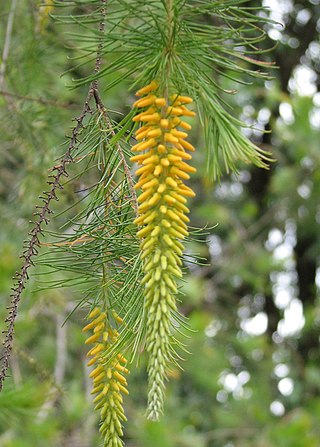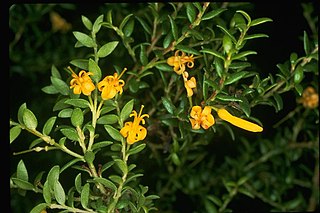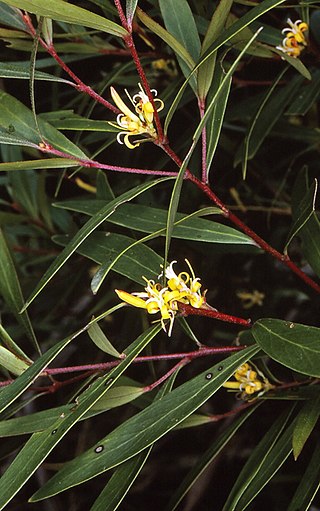
Persoonia pinifolia, commonly known as pine-leaved geebung or as mambara in the Cadigal language, is a species of flowering plant in the family Proteaceae and is endemic to the Sydney region of New South Wales. It is an upright, woody shrub with soft, pine-like foliage and long, terminal racemes of small yellow flowers in late winter to summer.

Hibbertia sericea, commonly known as silky guinea-flower, is a species of flowering plant in the family Dilleniaceae and is endemic to south-eastern Australia. It is an erect or spreading shrub with softly-hairy branches, elliptic to egg-shaped leaves with the narrower end towards the base, and yellow flowers with eight to fourteen stamens in a cluster on one side of two hairy carpels.

Persoonia cornifolia is a plant in the family Proteaceae and is endemic to eastern Australia. It is a shrub with elliptic to egg-shaped leaves and hairy yellow flowers, and grows in northern New South Wales and south-eastern Queensland.

Persoonia rigida, commonly known as the rigid-, hairy- or stiff geebung, is a species of flowering plant in the family Proteaceae and is endemic to south-eastern Australia. It is an erect to low-lying shrub with hairy young branchlets, lance-shaped to spatula-shaped leaves that are hairy when young, and yellow flowers borne in groups of up to twenty on a rachis up to 90 mm (3.5 in) long that continues to grow after flowering.

Persoonia confertiflora, commonly known as cluster-flower geebung, is a species of flowering plant in the family Proteaceae and is endemic to south-eastern Australia. It is an erect to low-lying shrub with hairy young branches, egg-shaped to narrow elliptic leaves, and hairy yellow flowers borne on leaf axils or on the ends of short branches.

Persoonia oxycoccoides is a species of flowering plant in the family Proteaceae and is endemic to New South Wales, Australia. It is a spreading to prostrate shrub with smooth bark, hairy young branchlets, elliptic to egg-shaped leaves and yellow flowers arranged in groups of up to thirteen along a rachis that continues to grow after flowering.

Persoonia myrtilloides, commonly known as myrtle geebung, is a plant in the family Proteaceae and is endemic to New South Wales. It is an erect to spreading shrub with elliptic to egg-shaped leaves and yellow flowers in groups of up to forty on a rachis up to 170 mm (6.7 in) long.

Persoonia hirsuta, commonly known as the hairy geebung or hairy persoonia, is a species of flowering plant in the family Proteaceae. It is endemic to eastern New South Wales, Australia. It is a hairy, spreading to low-lying shrub with linear, lance-shaped or spatula-shaped leaves and yellow or orange flowers arranged singly or in groups of up to ten on a rachis up to 20 mm (0.79 in) long.

Persoonia marginata, commonly known as the Clandulla geebung, is a plant in the family Proteaceae and is endemic to New South Wales, Australia. It is a low, spreading shrub with elliptic to egg-shaped leaves and small groups of cylindrical yellow flowers.

Persoonia procumbens is a plant in the family Proteaceae and is endemic to part of the New England Tableland, Australia. It is a prostrate shrub with rather fleshy, relatively large leaves and small groups of cylindrical yellow flowers. It is similar to P. daphnoides but has darker hairs on the young branches and smaller, less hairy flowers.

Persoonia elliptica, commonly known as snottygobble or spreading snottygobble, is a plant in the family Proteaceae and is endemic to the south-west of Western Australia. It is an erect shrub or small tree with egg-shaped or lance-shaped leaves and groups of cylindrical yellow flowers. It usually grows in woodland or forest dominated by jarrah or marri within 50 km (30 mi) of the coast.

Persoonia silvatica, commonly known as the forest geebung, is a plant in the family Proteaceae and is endemic to south-eastern Australia. It is a shrub or tree with more or less lance-shaped leaves and small groups of yellow flowers with white centres. It grows mainly in forest near the border between New South Wales and Victoria.

Persoonia chamaepeuce, commonly known as the dwarf geebung or heathy geebung, is a plant in the family Proteaceae and is endemic to south-eastern Australia. It is a prostrate shrub with crowded, linear leaves and yellow flowers in the leaf axils.

Persoonia asperula, commonly known as mountain geebung, is a plant in the family Proteaceae and is endemic to south-eastern Australia. It is an erect or prostrate shrub with smooth bark, mostly elliptic to oblong leaves and yellow flowers borne singly or in groups of up to nine. It mostly occurs in the Southern Highlands of New South Wales. A small population in Victoria may be a different species.

Persoonia oblongata is a species of plant in the family Proteaceae and is endemic to New South Wales, Australia. It is an erect to spreading shrub with narrow elliptic to broad egg-shaped leaves and yellow flowers on long, curved pedicels and is found from the lower Blue Mountains, west to Rylstone.

Persoonia adenantha is a plant in the family Proteaceae and is endemic to eastern Australia. It is an upright shrub or small tree with smooth, elliptic to lance-shaped leaves and groups of hairy yellow flowers. It has sometimes been confused with P. cornifolia and P. stradbrokensis.

Persoonia daphnoides is a plant in the family Proteaceae and is endemic to a restricted area in eastern Australia. It is a prostrate shrub with spatula-shaped to egg-shaped leaves with the narrower end towards the base, and yellow flowers in groups of up to eight on a rachis up to 35 mm (1.4 in) long.

Persoonia acuminata is a plant in the family Proteaceae and is endemic to New South Wales, Australia. It is a spreading or prostrate shrub with relatively small leaves and cylindrical yellow flowers arranged singly or in groups of up to sixteen in leaf axils or on the ends of the branches. It grows in moist forest on the higher parts of the tablelands.

Persoonia microphylla is a species of flowering plant in the family Proteaceae and is endemic to New South Wales. It is an erect to prostrate shrub with elliptic to egg-shaped leaves and yellow flowers in groups of up to fourteen on a rachis up to 30 mm (1.2 in) long.

Persoonia saccata, commonly known as snottygobble, and cadgeegurrup in indigenous language, is a plant in the family Proteaceae and is endemic to the south-west of Western Australia. It is usually an erect shrub and has linear leaves and groups of up to fifty or more irregularly shaped, yellow flowers which are hairy on the outside. It usually grows in woodland dominated by jarrah, marri or large Banksia species.




















